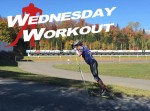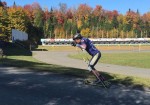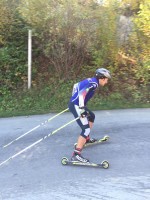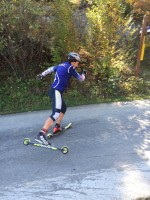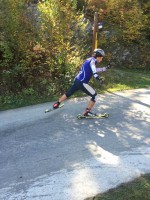This week’s workout comes from Russell Currier of the Maine Winter Sports Center. A 2014 Olympic biathlete, Currier, 28, recently placed second in the US Biathlon trials, narrowly missing the cut for a national-team camp in Park City, Utah.
“The shape was pretty much what I wanted,” Currier wrote in an email after the second set of trials earlier this month. “It wasn’t great, but it shouldn’t be too fast in October. This year it felt less of a race for a 4th or 5th [World Cup quota] spot race and more of competition against the whole National team. It’s nice that the team has made improvements, but it makes qualifying in October more difficult.
From here, he’ll focus on the next set of team trials in December at Mt. Itasca in Coleraine, Minn.
***
It may have been the start of the 2009, or maybe it was the 2010, training season when I first saw “TSS” written in a training plan sent to my inbox. Confused, I asked my coach for an explanation during a Skype meeting. To the best of my memory it was described as “rollerskiing up a short and steep hill while focusing on the best form and longest glide possible.” Or something along those lines. If I have to describe it to another athlete, I tend to start with saying it’s your most aggressive downhill technique, while skiing uphill. Truthfully, the first question usually refers to not knowing what TSS stands for. Since, this isn’t the most popular training idea in US Biathlon history, the answer may vary depending on who you ask. The common reply has been “Top Secret Strength” or just “Top Secret Stuff.” My personal favorite is “Totally Stupid Strength.”
Another way of describing TSS would be to think of it as hill bounding on skis. If you had to combine a weight-room strength session with a rollerski-technique drill session the result would be TSS. It’s on my training plan year round. All you need is a short, steep climb you can ski up and down repeatably without being in the way. You’re only going as far as you can in 20 poles plants so it doesn’t really need to be an alpine hill.
“If you had to combine a weight-room strength session with a rollerski-technique drill session the result would be TSS.” — Russell Currier, Maine Winter Sports Center (MWSC) Olympic Development Team biathlete
The purpose is to reinforce good ski technique and power with the exact muscle groups involved in that technique. The focus is to generate the best form and longest distance per cycle as you can. Any choice of skate technique will work. Sometimes this tends to feel like skiing in slow motion. Sometimes it feels strange to be forcing a slow tempo V2 alternate up a wall, but it also makes it feel that much natural on the flats and downhills. One of the advantages it has over hill bounding on foot is the use of double pole, adding an upper body component. In my experience, this is as effective doing core strength in a gym.
The Workout: Technique Specific Strength
The Place: Groomed trails or pavement. Steep, approximately 30-meter-long climb.
Warmup: Easy distance skating 15 to 20 minutes.
The Important Part:
– 5 x 20 Double Poles
– 2 x 20 Skating without poles
– 2 x 20 V2 cycles
Repeat once or twice and add some extra V2 alternate and V1 sets if the energy is still there. Should be 15 to 25 cycles, or pole plants, depending on the technique.
Total routine is about 25 to 45 minutes.
Cool Down:
20 to 30 minutes easy skiing or running
When there is a bad habit in your technique that you can’t seem to forget, this is the workout to use to combat that habit with a correct one. TSS doesn’t require a lot of resources beyond decent trails and functional equipment. This is a strength training that contributes directly to the sport we’re trying to compete it. I’m always trying to update the quality of training in my plan. That being said, the afternoon TSS sessions still find a place in my average week.

